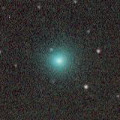
|
Brightening very rapidly. Now it is very bright as 8.3 mag (Dec. 16, Katsumi Yoshimoto). It will approach to the earth down to 0.08 a.u. to the earth in mid February, and it is expected to be observable at 6 mag in good condition. It keeps very low in the evening sky for a while. It will be unobservable temporarily in January. Then it keeps observable in good condition after mid February.
Date(TT) R.A. (2000) Decl. Delta r Elong. m1 Best Time(A, h)
Dec. 17 20 14.70 -22 25.2 1.007 0.611 35 9.3 18:21 ( 53, 11)
Dec. 24 20 37.71 -20 53.4 0.864 0.554 34 8.0 18:24 ( 55, 11)
|
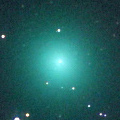
|
Brightening rapidly. Now it is very bright as 9.9 mag (Dec. 11, Michael Jager). It will approach to the sun down to 0.3 a.u. on Jan. 14. It may brighten up to 6 mag. In the Northern Hemisphere, it keeps observable in the morning sky until early January while the comet will be brightening. It is not observable at all in the Southern Hemisphere.
Date(TT) R.A. (2000) Decl. Delta r Elong. m1 Best Time(A, h)
Dec. 17 16 2.85 25 54.0 0.719 0.815 54 9.4 5:31 (257, 29)
Dec. 24 16 47.88 13 55.9 0.773 0.665 42 8.7 5:34 (266, 20)
|
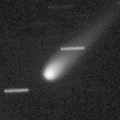
|
Now it is 12.0 mag (Dec. 5, Maik Meyer). It is expected to brighten up to 7 mag in 2017 summer. In the Northern Hemisphere, it keeps observable in good condition until the highlight while the comet will be brightening. In the Southern Hemisphere, it is not observable until early 2017.
Date(TT) R.A. (2000) Decl. Delta r Elong. m1 Best Time(A, h)
Dec. 17 14 0.69 44 12.6 2.706 2.782 84 11.3 5:31 (241, 57)
Dec. 24 14 15.92 44 5.4 2.598 2.716 86 11.1 5:34 (241, 60)
|
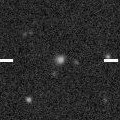
|
Appearing in the morning sky. Now it is 14.0 mag (Nov. 22, Ken-ichi Kadota). It is expected to brighten up to 7 mag in 2017 spring. But it locates somewhat low at the high light.
Date(TT) R.A. (2000) Decl. Delta r Elong. m1 Best Time(A, h)
Dec. 17 14 35.46 -17 51.4 3.026 2.405 43 12.7 5:31 (309, 19)
Dec. 24 14 49.66 -18 49.0 2.882 2.322 46 12.5 5:34 (313, 21)
|
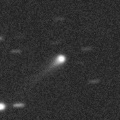
|
It brightened very rapidly and became brighter than expected. Now it is very bright as 12.5 mag (Nov. 1, Chris Wyatt). It is not observable already in the Southern Hemisphere. It will be unobservable soon also in the Northern Hemisphere.
Date(TT) R.A. (2000) Decl. Delta r Elong. m1 Best Time(A, h)
Dec. 17 19 8.48 -14 42.4 2.926 2.054 22 13.8 18:21 ( 69, 4)
Dec. 24 19 25.33 -13 55.8 2.965 2.069 20 14.0 18:24 ( 72, 2)
|

|
Now it is 16.5 mag (Nov. 29, Michael Jager). It will brighten up to 12 mag from winter to spring. In the Northern Hemisphere, it keeps observable while the comet is brightening gradually. But it will be unobservable in late February. In the Southern Hemisphere, it keeps unobservable until December. But it keeps observable for a long time after late December.
Date(TT) R.A. (2000) Decl. Delta r Elong. m1 Best Time(A, h)
Dec. 17 14 19.97 -5 26.9 1.959 1.546 51 14.3 5:31 (303, 31)
Dec. 24 14 42.02 -7 29.2 1.861 1.482 52 13.9 5:34 (307, 31)
|

|
It was observed as bright as 12-13 mag from late October to early November. Now it is fainter than 14.3 mag (Dec. 1, Chris Wyatt). It will be unobservable in mid December.
Date(TT) R.A. (2000) Decl. Delta r Elong. m1 Best Time(A, h)
Dec. 17 19 57.88 -22 11.0 6.692 5.880 31 13.9 18:21 ( 56, 8)
Dec. 24 20 3.45 -21 50.3 6.745 5.878 26 13.9 18:24 ( 60, 4)
|
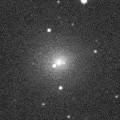
|
It brightened up to 11-12 mag in autumn. Now it is fading. But it is bright as 13.3 mag still now (Dec. 2, Seiichi Yoshida). It is getting higher gradually after this also in the Southern Hemisphere.
Date(TT) R.A. (2000) Decl. Delta r Elong. m1 Best Time(A, h)
Dec. 17 12 57.36 -10 12.7 1.981 1.856 68 14.2 5:31 (327, 39)
Dec. 24 13 8.56 -11 27.6 1.955 1.901 72 14.4 5:34 (333, 39)
|

|
Now it is 15.2 mag (Nov. 17, Ken-ichi Kadota). It will brighten up to 14 mag from winter to spring in 2017, and it will be observable in excellent condition in the Northern Hemisphere. It keeps low in the Southern Hemisphere.
Date(TT) R.A. (2000) Decl. Delta r Elong. m1 Best Time(A, h)
Dec. 17 11 33.46 24 55.4 2.035 2.422 100 14.3 5:31 (336, 79)
Dec. 24 11 41.89 25 13.2 1.964 2.424 105 14.3 5:31 ( 0, 80)
|
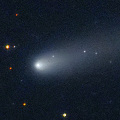
|
It brightened up to 11-12 mag from summer to autumn. Now it is fading. But it is bright as 13.3 mag still now (Dec. 2, Seiichi Yoshida).
Date(TT) R.A. (2000) Decl. Delta r Elong. m1 Best Time(A, h)
Dec. 17 12 2.59 -18 15.0 1.811 1.868 77 14.4 5:31 (346, 35)
Dec. 24 12 10.80 -19 56.1 1.784 1.916 82 14.6 5:34 (353, 35)
|

|
Now it is 14.2 mag (Nov. 22, Chris Wyatt). Distant object, but it keeps observable at 13-14 mag for a long time from 2015 to 2016.
Date(TT) R.A. (2000) Decl. Delta r Elong. m1 Best Time(A, h)
Dec. 17 0 37.44 -5 11.9 4.819 5.102 101 14.5 18:52 ( 0, 50)
Dec. 24 0 39.80 -5 0.5 4.941 5.117 94 14.6 18:27 ( 0, 50)
|

|
It brightened up to 11 mag from spring to summer. Now it is not observable. It will be observable at 16 mag again in 2017 spring.
Date(TT) R.A. (2000) Decl. Delta r Elong. m1 Best Time(A, h)
Dec. 17 16 59.97 -20 42.0 3.095 2.130 9 14.8 5:31 (289, -9)
Dec. 24 17 16.00 -21 3.3 3.118 2.170 12 14.9 5:34 (291, -6)
|

|
Now it is 16.5 mag (Nov. 28, Michael Jager). It will pass the perihelion on Mar. 10, 2017. In the Northern Hemisphere, it keeps observable in the evening sky until late February while the comet will be brightening up to 8.5 mag. In the Southern Hemisphere, it will appear in the morning sky in late March at 8 mag, then it keeps observable while the comet will be fading.
Date(TT) R.A. (2000) Decl. Delta r Elong. m1 Best Time(A, h)
Dec. 17 22 53.90 4 3.6 1.413 1.595 81 15.6 18:21 ( 32, 55)
Dec. 24 22 56.78 3 59.2 1.422 1.503 74 15.0 18:24 ( 43, 51)
|

|
Now it is bright as 15.3 mag (Nov. 22, Thomas Lehmann). It will be observable at 11 mag for a long time from 2017 to 2018. Now it is observable in excellent condition in the Southern Hemisphere. But it keeps low for a while in the Northern Hemisphere.
Date(TT) R.A. (2000) Decl. Delta r Elong. m1 Best Time(A, h)
Dec. 17 2 57.73 -38 56.8 5.191 5.562 107 15.0 21:11 ( 0, 16)
Dec. 24 2 54.08 -37 59.2 5.200 5.509 103 15.0 20:40 ( 0, 17)
|
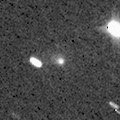
|
Now it is 16.0 mag (Nov. 3, Kunihiro Shima). It will brighten up to 15 mag in winter. But it will be getting lower gradually after this.
Date(TT) R.A. (2000) Decl. Delta r Elong. m1 Best Time(A, h)
Dec. 17 22 46.33 0 3.6 1.800 1.862 77 15.4 18:21 ( 32, 51)
Dec. 24 22 58.16 1 37.1 1.840 1.834 74 15.4 18:24 ( 40, 50)
|

|
It brightened up to 6 mag from last autumn to last winter. Now it is fading. It has already faded down to 15.2 mag (Nov. 2, Yuji Ohshima). It is observable in good condition in the Northern Hemisphere. It is not observable after this in the Southern Hemisphere.
Date(TT) R.A. (2000) Decl. Delta r Elong. m1 Best Time(A, h)
Dec. 17 3 31.14 54 11.1 4.446 5.248 140 15.4 21:45 (180, 71)
Dec. 24 3 21.33 53 9.0 4.559 5.316 136 15.5 21:08 (180, 72)
|

|
Now it is 15.0 mag (Nov. 2, Kunihiro Shima). It will brighten up to 12-13 mag and will be observable in good condition in 2017 summer. In 2016, it keeps observable until winter when it will brighten up to 15.5 mag. It locates somewhat low in the Southern Hemisphere.
Date(TT) R.A. (2000) Decl. Delta r Elong. m1 Best Time(A, h)
Dec. 17 0 32.15 19 38.4 3.303 3.745 109 15.5 18:46 ( 0, 75)
Dec. 24 0 25.20 18 25.1 3.392 3.700 100 15.5 18:24 ( 10, 73)
|

|
Appearing in the morning sky in the Northern Hemisphere. Now it is fading. But it must be bright as 15 mag still now.
Date(TT) R.A. (2000) Decl. Delta r Elong. m1 Best Time(A, h)
Dec. 17 15 11.93 -19 11.9 2.830 2.095 34 15.5 5:31 (304, 12)
Dec. 24 15 26.32 -19 44.4 2.848 2.162 38 15.6 5:34 (307, 14)
|

|
Now it is 15.4 mag (Nov. 19, Ken-ichi Kadota). It will brighten up to 14 mag from summer to winter in 2017. Then it will be observable in excellent condition in the Northern Hemisphere. In the Southern Hemisphere, it is hardly observable around the highlight.
Date(TT) R.A. (2000) Decl. Delta r Elong. m1 Best Time(A, h)
Dec. 17 22 48.44 -7 37.0 4.239 4.103 75 15.8 18:21 ( 27, 44)
Dec. 24 22 49.53 -6 29.3 4.312 4.064 68 15.8 18:24 ( 37, 42)
|

|
Now it is 17.0 mag (Nov. 5, Kunihiro Shima). It will be observable at 16-17 mag in good condition from autumn to winter. It locates low in the Southern Hemisphere.
Date(TT) R.A. (2000) Decl. Delta r Elong. m1 Best Time(A, h)
Dec. 17 7 22.65 25 55.9 2.870 3.793 156 15.9 1:40 ( 0, 81)
Dec. 24 7 18.20 26 15.3 2.829 3.785 164 15.8 1:08 ( 0, 81)
|

|
It will brighten up to 14 mag from spring to summer in 2017. It locates somewhat low in the Northern Hemisphere. The perihelion distance increased from 2.4 a.u. to 2.9 a.u. in this apparition. So it will not be bright as before.
Date(TT) R.A. (2000) Decl. Delta r Elong. m1 Best Time(A, h)
Dec. 17 14 54.03 -12 49.0 3.944 3.259 40 15.9 5:31 (302, 19)
Dec. 24 15 3.22 -13 34.0 3.861 3.245 45 15.9 5:34 (307, 22)
|
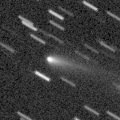
|
Now it is 15.8 mag (Nov. 23, Katsumi Yoshimoto). It will be observable at 15-16 mag in good condition from autumn to winter. It locates somewhat low in the Southern Hemisphere.
Date(TT) R.A. (2000) Decl. Delta r Elong. m1 Best Time(A, h)
Dec. 17 4 10.31 33 38.6 1.823 2.760 157 15.9 22:24 ( 0, 89)
Dec. 24 4 6.72 33 13.5 1.880 2.782 151 16.1 21:53 ( 0, 88)
|
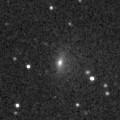
|
Now it is 15.6 mag (Nov. 19, Ken-ichi Kadota). It keeps 16-17 mag for a long time from 2016 to 2019. It keeps locating near by the equator.
Date(TT) R.A. (2000) Decl. Delta r Elong. m1 Best Time(A, h)
Dec. 17 9 22.73 1 35.6 9.118 9.672 121 16.0 3:40 ( 0, 57)
Dec. 24 9 22.17 1 39.3 9.020 9.666 128 16.0 3:12 ( 0, 57)
|

|
It has been lost since its discovery in 1978. In 2016, it is expected to return in excellent condition from autumn to winter.
Date(TT) R.A. (2000) Decl. Delta r Elong. m1 Best Time(A, h)
Dec. 17 23 53.80 -3 49.9 0.903 1.356 91 16.1 18:21 ( 4, 51)
Dec. 24 0 16.66 -0 34.1 0.953 1.384 91 16.4 18:24 ( 8, 54)
|
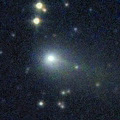
|
It brightened up to 12.5 mag in summer (Aug. 3, Marco Goiato). Now it is fading. It has already faded down to 15.2 mag (Nov. 3, Kunihiro Shima). It keeps observable in good condition for a while.
Date(TT) R.A. (2000) Decl. Delta r Elong. m1 Best Time(A, h)
Dec. 17 22 11.11 -13 14.2 3.320 3.034 64 16.4 18:21 ( 35, 35)
Dec. 24 22 20.27 -12 29.0 3.436 3.065 60 16.5 18:24 ( 41, 33)
|

|
Now it is 16.5 mag (Nov. 4, D. Buczynski). It will brighten up to 15 mag and will be observable in good condition from autum to winter in 2017. In the Northern Hemisphere, it keeps observable in good condition for a long time while the comet will be brightening. It is not observable until 2017 summer in the Southern Hemisphere.
Date(TT) R.A. (2000) Decl. Delta r Elong. m1 Best Time(A, h)
Dec. 17 2 27.46 52 51.4 4.485 5.211 133 16.4 20:41 (180, 72)
Dec. 24 2 17.97 51 9.7 4.517 5.179 127 16.4 20:04 (180, 74)
|

|
It brightened up to 15 mag in early 2016. Now it is fading. It has already faded down to 16.5 mag (Nov. 19, Ken-ichi Kadota). In the Northern Hemisphere, it keeps observable in good condition for a long time until 2017 autumn when the comet will be fainter than 18 mag. It will never be observable after this in the Southern Hemisphere.
Date(TT) R.A. (2000) Decl. Delta r Elong. m1 Best Time(A, h)
Dec. 17 14 53.51 65 56.4 5.961 6.120 94 16.7 5:31 (209, 46)
Dec. 24 15 2.32 66 7.6 5.960 6.147 96 16.8 5:34 (207, 48)
|

|
It brightened up to 8-9 mag from last winter to spring. Now it is fading. It has already faded down to 16.4 mag (Dec. 2, Ken-ichi Kadota).
Date(TT) R.A. (2000) Decl. Delta r Elong. m1 Best Time(A, h)
Dec. 17 13 12.72 -9 36.7 4.838 4.509 64 16.8 5:31 (322, 37)
Dec. 24 13 14.29 -10 27.2 4.786 4.567 71 16.9 5:34 (331, 40)
|
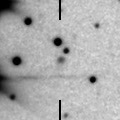
|
Now it is 16.7 mag (Nov. 3, iTelescope Observatory, Siding Spring). It keeps 16 mag for a long time from 2017 to 2018.
Date(TT) R.A. (2000) Decl. Delta r Elong. m1 Best Time(A, h)
Dec. 17 9 41.32 -11 19.3 5.464 5.895 111 16.9 3:58 ( 0, 44)
Dec. 24 9 37.66 -10 52.8 5.336 5.874 118 16.8 3:27 ( 0, 44)
|
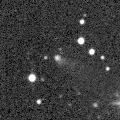
|
It brightened rapidly. Now it is 16.7 mag (Oct. 15, Ken-ichi Kadota). It is observable at 16.5 mag in good condition from autumn to winter.
Date(TT) R.A. (2000) Decl. Delta r Elong. m1 Best Time(A, h)
Dec. 17 23 6.20 -3 55.1 2.569 2.601 80 16.8 18:21 ( 23, 49)
Dec. 24 23 14.08 -2 46.7 2.649 2.593 75 16.9 18:24 ( 32, 48)
|
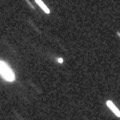
|
Now it is 16.9 mag (Nov. 25, Ken-ichi Kadota). It brightened rapidly, and became brighter than originally expected. It keeps 17 mag until 2017. In the Northern Hemisphere, it keeps observable in excellent condition for a long time. It is not observable in the Southern Hemisphere.
Date(TT) R.A. (2000) Decl. Delta r Elong. m1 Best Time(A, h)
Dec. 17 13 46.45 55 12.5 7.208 7.323 92 16.9 5:31 (220, 57)
Dec. 24 13 46.65 55 38.8 7.148 7.328 96 16.9 5:34 (216, 61)
|

|
Now it is 17.3 mag (Nov. 7, Mt. Lemmon Survey). It will be observable at 17 mag in good condition in winter.
Date(TT) R.A. (2000) Decl. Delta r Elong. m1 Best Time(A, h)
Dec. 17 12 19.27 -0 33.0 2.381 2.423 80 17.0 5:31 (333, 51)
Dec. 24 12 26.82 -0 58.6 2.318 2.452 85 17.0 5:34 (343, 53)
|

|
It will brighten up to 10 mag in 2017 summer, and it will be observable in excellent condition in the Southern Hemisphere. It locates low in the Northern Hemisphere.
Date(TT) R.A. (2000) Decl. Delta r Elong. m1 Best Time(A, h)
Dec. 17 13 34.68 -2 5.6 2.614 2.334 62 17.2 5:31 (311, 40)
Dec. 24 13 46.47 -3 11.2 2.499 2.296 66 17.0 5:34 (317, 42)
|
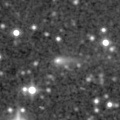
|
Now it is 17.4 mag (Nov. 25, Ken-ichi Kadota). In the Northern Hemisphere, it will be observable at 17 mag in excellent condition in winter. It locates low in the Southern Hemisphere.
Date(TT) R.A. (2000) Decl. Delta r Elong. m1 Best Time(A, h)
Dec. 17 7 12.58 34 34.4 2.476 3.402 156 17.1 1:30 ( 0, 90)
Dec. 24 7 8.42 34 47.3 2.455 3.407 162 17.1 0:59 ( 0, 90)
|
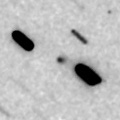
|
Now it is 17.9 mag (Nov. 2, Purple Mountain Observatory, XuYi Station). It was observed at 17 mag last winter. It will be observable at 17 mag again next winter. It is observable in good condition in the Northern Hemisphere. But it locates low in the Southern Hemisphere.
Date(TT) R.A. (2000) Decl. Delta r Elong. m1 Best Time(A, h)
Dec. 17 11 18.69 19 31.2 3.562 3.890 102 17.2 5:31 (356, 74)
Dec. 24 11 22.01 20 53.3 3.482 3.910 108 17.1 5:11 ( 0, 76)
|

|
It will pass the perihelion in 2019. However, it has not been brightening since the discovery in 2010. Now it is 17.3 mag (Nov. 4, D. Buczynski). It keeps observable in excellent condition in the Northern Hemisphere. It is not observable in the Southern Hemisphere.
Date(TT) R.A. (2000) Decl. Delta r Elong. m1 Best Time(A, h)
Dec. 17 4 1.61 62 5.9 8.907 9.659 137 17.2 22:16 (180, 63)
Dec. 24 3 57.05 62 3.1 8.916 9.640 135 17.2 21:44 (180, 63)
|
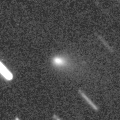
|
It had been lost for a long time over 200 years since its discovery in 1783. It brightened rapidly, and reached up to 13.9 mag in September (Spet. 1, Sandor Szabo). Now it is fading. It is observable in excellent condition for a while in the Northern Hemisphere. It is not observable after this in the Southern Hemisphere.
Date(TT) R.A. (2000) Decl. Delta r Elong. m1 Best Time(A, h)
Dec. 17 3 37.35 57 18.9 1.159 2.012 139 17.3 21:51 (180, 68)
Dec. 24 3 21.08 58 12.1 1.231 2.042 134 17.7 21:07 (180, 67)
|
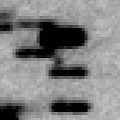
|
It will be observable at 17.5 mag in good condition from winter to spring.
Date(TT) R.A. (2000) Decl. Delta r Elong. m1 Best Time(A, h)
Dec. 17 13 35.29 -4 24.8 2.551 2.257 61 17.4 5:31 (313, 38)
Dec. 24 13 47.00 -5 28.0 2.485 2.265 65 17.4 5:34 (319, 40)
|

|
Now it is 17.3 mag (Nov. 9, L. Elenin). It keeps 17 mag for a long time from 2016 autumn to 2017 summer, and it keeps observable good condition all through that period in the Southern Hemisphere. In the Northern Hemisphere, it will never be observable again after this.
Date(TT) R.A. (2000) Decl. Delta r Elong. m1 Best Time(A, h)
Dec. 17 2 34.78 -64 39.1 2.440 2.551 85 17.5 20:47 ( 0,-10)
Dec. 24 2 16.78 -64 53.0 2.490 2.531 81 17.5 20:02 ( 0,-10)
|

|
Now it is 18.8 mag (Dec. 8, Mt. Lemmon Survey). It will approach to the earth down to 0.14 a.u. from March to April. It is expected to brighten up to 5-6 mag. It may brighten furthermore in outburst. In the Northern Hemisphere, it keeps observable in excellent condition. In the Southern Hemisphere, it will not be observable for about one month around the highlight. But it keeps observable in good condition except for that period.
Date(TT) R.A. (2000) Decl. Delta r Elong. m1 Best Time(A, h)
Dec. 17 9 6.81 7 54.6 1.003 1.786 128 18.0 3:24 ( 0, 63)
Dec. 24 9 12.79 7 33.9 0.894 1.726 133 17.5 3:02 ( 0, 63)
|

|
Now it is 17.0 mag (Nov. 10, Purple Mountain Observatory, XuYi Station). It keeps observable at 17.5 mag in good condition from autumn to winter.
Date(TT) R.A. (2000) Decl. Delta r Elong. m1 Best Time(A, h)
Dec. 17 3 6.85 14 50.2 2.214 3.059 143 17.7 21:21 ( 0, 70)
Dec. 24 3 5.32 14 39.9 2.276 3.057 135 17.7 20:52 ( 0, 70)
|
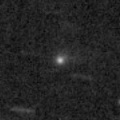
|
Now it is 17.0 mag (Nov. 2, Mitsunori Tsumura). It tends to be brightest after the perihelion passage. It is observable at 17.5 mag in good condition from autumn to winter.
Date(TT) R.A. (2000) Decl. Delta r Elong. m1 Best Time(A, h)
Dec. 17 2 5.29 0 5.1 2.513 3.161 123 17.8 20:20 ( 0, 55)
Dec. 24 2 5.87 0 32.8 2.608 3.173 116 17.9 19:53 ( 0, 56)
|
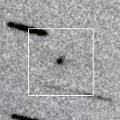
|
Now it is 17.5 mag (Oct. 24, D. Buczynski). It will brighten up to 16 mag in 2017 summer, but it is not observable around the high light. It is observable at 17-18 mag until March in the Southern Hemisphere, or until April in the Northern Hemisphere.
Date(TT) R.A. (2000) Decl. Delta r Elong. m1 Best Time(A, h)
Dec. 17 2 1.17 1 22.2 2.083 2.744 122 17.8 20:15 ( 0, 56)
Dec. 24 2 0.42 1 46.7 2.131 2.708 115 17.8 19:47 ( 0, 57)
|
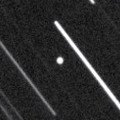
|
It brightened up to 14.9 mag in September (Sept. 29, Sandor Szabo). In the Northern Hemisphere, it keeps observable in excellent condition, but it will be fading after this. It keeps locating very low in the Southern Hemisphere.
Date(TT) R.A. (2000) Decl. Delta r Elong. m1 Best Time(A, h)
Dec. 17 23 32.36 21 10.4 1.521 1.906 96 17.9 18:21 ( 30, 74)
Dec. 24 23 41.54 20 19.5 1.662 1.957 91 18.2 18:24 ( 43, 71)
|
|
![]()
 53P/Van Biesbroeck
53P/Van Biesbroeck C/2015 V1 ( PanSTARRS )
C/2015 V1 ( PanSTARRS ) C/2013 V4 ( Catalina )
C/2013 V4 ( Catalina ) C/2014 S2 ( PanSTARRS )
C/2014 S2 ( PanSTARRS ) C/2016 A1 ( PanSTARRS )
C/2016 A1 ( PanSTARRS ) 188P/LINEAR-Mueller
188P/LINEAR-Mueller C/2014 R3 ( PanSTARRS )
C/2014 R3 ( PanSTARRS ) 118P/Shoemaker-Levy 4
118P/Shoemaker-Levy 4 71P/Clark
71P/Clark P/2015 TP200 ( LINEAR )
P/2015 TP200 ( LINEAR ) C/2015 X7 ( ATLAS )
C/2015 X7 ( ATLAS ) C/2010 U3 ( Boattini )
C/2010 U3 ( Boattini ) 226P/Pigott-LINEAR-Kowalski
226P/Pigott-LINEAR-Kowalski 94P/Russell 4
94P/Russell 4 P/2016 S1 ( PanSTARRS )
P/2016 S1 ( PanSTARRS ) 41P/Tuttle-Giacobini-Kresak
41P/Tuttle-Giacobini-Kresak 128P/Shoemaker-Holt 1
128P/Shoemaker-Holt 1 136P/Mueller 3
136P/Mueller 3 30P/Reinmuth 1
30P/Reinmuth 1 (3200) Phaethon
(3200) Phaethon![]()








































